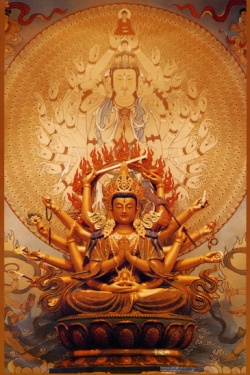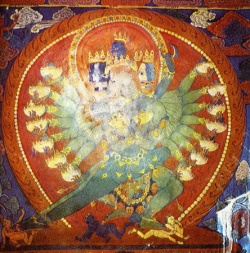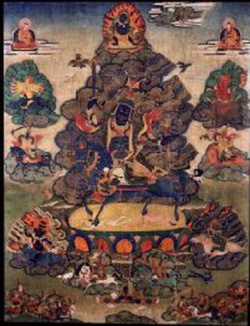Pratityasamudpada Hrdayakarika and auto commentary of Nagarjuna
Obeisance to Manjushree, the Youthful One
1. The twelve discrete constituents of Interdependent Origination which were taught by the sage are wholly collected in three: Afflictions, actions and miseries.
2. The first eighth and ninth are Afflictions klesh, the second and tenth are actions karma while the remaining seven are miseries, Thus the twelve elements nidana are collected in three.
3 From the three two Originates, from the two originates seven and from these seven in turn, originate the three; thus the Wheel of existence revolves again and again.
4 The entire World samsara is cause and effect, excluding these three there is no sentient being. From elements which are void in nature only empty elements originate.
5 Through the similes of oral instruction, a lamp, a mirror, a seal, a sun crystal, a seed, sourness and Sound/echo the wise should understand the non-transmigration, as well as the re-emergence of the Aggregates.
6 One who conceives even very subtle elements as non-existence fails to see an object which are dependently produced.
7 So there is nothing denied or affirmed [absolutely. See reality as it is for one who sees reality is released [from bondage of afflictions.
THE COMMENTARY
The disciple possessed of renunciation, desirous of hearing attentive retentive, appreciative and able to dispel thought construction having drawn near to the Master, asks thus about the doctrine of the Tathagata. In what are "the twelve discrete constituents of interdependent Origination which were taught by the blessed One, collected for I beg to see and study [them]. The Master having understood him to ask about the essence of those twelve elements, thus spoke these lucid words from the verse:
"[These twelve] are wholly collected in three:
Afflictions, actions and Misery" [1b]
Thus twelve is ten plus two. Constitucnts alone are discrete as the constituents of a chariot have been showed to be therefore discrete constituents. The sage is thus called because of the silence of Body speech and Mind. 'Taught by the sage' is synonymons with explained and elucidated. [The twelve constituents] do not orginate from cause like nature, intrinsic character niyati, Purusha, dependance through others, Karma [motivated action, God time, inherent character freewill "Brahma etc.
These are interdependently produced, As the well collected sticks stands upright depending upon one another, these twelve discrete constituents "Are wholly collected in three: Afflictions, actions and Miseries." Wholly means all without remainder.
Question: What are Afflictions, what actions and what miseries? How and in what manner are these constituents of Interdependent Origination collected?
Answer:
"The first, eighth and ninth are Afflictions" Of the twelve constituents the first is Ignorance, the eighth Craving and the ninth grasping. These three is to be known as Afflictions.
What is actions?
"the second and tenth are actions"
The second Mental formations samskara and the tenth Becoming these two elements fall on the category of actions.
"the remaining seven also are miseries"
With the exception of five elements falling under the categories of actions and Afflictions the remaining seven elements fall on the category of Miseries. Thus Consciousness, Name and Form, Six sense Spheres, contact, Feeling, birth old age and Death. The word 'also' serves to indicate miseries like the separation from beloved, meeting with despised and not finding what one desires.
"Thus twelve elements are collected in three"
Thus these twelve elements are to be known as Afflictions, actions and miseries. The Sanskrit word 'tu' serves to indicate that the twelve constituents explained in the Sutra are complete nothing miore to add or subrtact on it. Thus it has been determined that there are mone apart from these. [2]
Question:
"Just so, but please explain what these Afflictions, actions and miseries originate from?
Answer: "From the three two originate." From the three which are Afflictions, ignorance, craving and grasping "two" which are actions mental fromations and becoming] originate seven explained above as miseries. From the seven in turn originate 'the three' which are Afflictions, as explained, Thus again from the three [which are] Afflictions originate 'the two'. Thus the Wheel of existence revolves again and again. [3]
[In the world of] becoming there are three realms namely desire realm, Form realm and Formless realm. The Sentient beings in these realms have be come like a Wheel which revolves without rest. The word 'tu' in the text indicates a sense of uncertainty. That is, while a Wheel revolves successively [each point following upon the preceding one] but in the thr4ee realms it does not happen thus. [3]
Question: Who is called the sentient being, superlord of all individuals? How is his creation?
Answer: The whole World is cause and effect. Excluding false imputation there is no sentient being. Inreality an imputed object when analyzed does not exist. Thus it is not fitting that what is just falsely imputed should exist substantially when one desires.
Questions; If so, then who transmigrates from this World to the next?
Answer; Even not an atom transmigrates from this World to the next, however, from the elements [which are] empty in nature empty elements originate."[4b]
The entities are devoid of self and self-hood thus the Afflictions and actions have become the causes. From these five causes ignorance, craving, grasping mental formations and becoming] which are empty originate miseries devoid of self and self-hood. The seven elements consciousness, name and form, the six sense spheres, contact, feeling birth, oldage and death which are empty in nature are imputed to effects. Such is the purport.
Thus what is devoid of self-hood is neither self nor self-hood.
However, from elements which are non-self in nature originate elements which ate also non-self in nature. Thus it is to be understood as explained.
Question: [If] from elements which are non-self in na6ture originate elements which are non-self in nature. What are examples of this?
Here it is said:
Through examining the example of oral instruction, a lamp, a mirror, a sun crystal, a seed, sourness, and Sound although they are imputed only it establishes the validity of transmigration and its own being devoid of self, for instance, if the words uttered from the Master's mouth have transferred to the Disciple then Master [would] become devoid of the words [of Instruction] Therefore there is no transference. [Yet} the instructions received by the disciple did not come from any other source other than the Master's. Because, if so they would be without cause.
Just as in the instructions of a Master to his disciple, so in a like manner the dying mind pratisandhi citta does not transmigrate to the subsequent realm because this would result in enternalism sasvata Nor does the subsequent realm originates from any other source other than dying Mind, for this would result in the error of Nihilism Uchched.
As the Master's instructions [words] are the cause of Disciple's learning yet whether the works of the Master and the utterance of the Disciple are identical or different, is inexpressible. So in a like manner whether the dying Mind and the Mind at the time of Rebirth pratisandhi citta are identical or different is inexpressible.
Similarly, from a flame an oil lamp is kindled, from a mirror an image is produced, from a seal an imprint is formed, from a sun crystal Fire is issued, from a seed a sprout, from the juice of a sour fruit saliva is produce and again from a Sound an echo is produced.
Thus the wise should understand that five Aggregates do not transmigrate to the next realm existence [5b]
There are five Aggregates namely from, Feeling, Perception, Mental formation and consciounes. The transmigration of these five Aggregates is forbidden because the fruits begot from the cause [i, e a seed] is different from its cause.
Therefore not even a particle of atom transmigrates from this World to the next [when one dies. One takes birth again and again in this Samsara only due to wrong conceptualisation (bhranti vikalpa.]
The particle 'tu' also suggest opposite [wrong conceptualisation] which is to be avoided [nivartayitavyam]. One who understand entities as permanent for Impermanent, Happiness for Suffering, substantial for empty, self for no self is deluded. When one is free from Delusion, there will be no Attachment, in the absence of Attachment hatred will not occur, in the absence of hatred one does not perform actions Karma. In the absence of Karma grasping of entities do not arise. In the absence of grasping becoming will not be occured, in the absence of Rebirth there will not be the miseries of the Body and Mind.
In this way if we do not think five Aggregates which are causes in wrong way the effect will not be produce, It is befitting to understand it as Liberation moksa, Only in this manner we can eliminate the two extreme views eternalism and nihilism
The commentary to the Heart of Pratiyasamutpada Hrdayakarika composed by Acharya Nagarjuna is herein complete.




